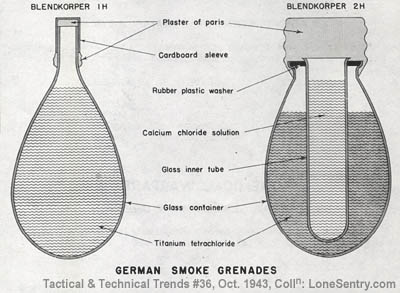Panzerhandgranaten
The first special AT hand grenade was the Panzerhandgranate 41. It weighed 2kg and was effective against armor of up to 30mm thickness. 504,600 were produced in early 1943. Further developments of AT handgrenades utilising shaped charges had trouble stabilizing the flight which was necessary for the shaped charge to work (this lead to the development of the Panzerwurfmine).
SS-HL-Handgranate.

The SS-weapon’s academy then invented the HL-Handgranate that was also often referred to as the SS-HL-Handgranate to denominate it’s inventor (see pictures at left and right). It had a length of 19cm, weighed 420g including the shaped charge of 210g and had a diameter of 7.2 cm. It’s front consisted of a felt disc which was 6mm thick and drenched with glue. The idea was to run up to the tank and stick the grenade onto the armor. This method to attach the AT grenade to the tank proved to be less practical than intended, the weapon proved rather unsuccessful and unpopular, therefore further developments centered around the Hafthohlladung which seemed more promising.
Panzerhandmine / Hafthohlladung
Small early trials with Panzerhandminen with shaped charges of 300 and 400g did not prove successful. The first usable weapon, the Panzerhandmine 3 or PzHM 3, had a bottle-like shape with a length of 27cm and a diameter of 14cm. Three strong U-magnets were to fix the weapon to steel armor of the tank it was attached onto by daring infantrymen. It carried a shaped charge of 1000g capable of penetrating 130mm of armor. The successor model, the Panzerhandmine 4, was a little bigger and had stronger magnets and an improved penetration performance of 150mm.
Panzerhandminen 4.

The spikes in this weapons were used to attach the handgrenade to wooden pillboxes.

First use of the PzHM 3 was in the battles at the Wolchow in russia in May 1942 and the german coastal defense of Dieppe in the failed operation “Jubilee”.
The Panzerhandminen were succeeded by the larger weapon family of the Hafthohlladung (“attach hollow charge”) which were basically enlarged Panzerhandminen. The single important type, the Hafthohlladung 3, had a shaped charge of 1.5kg that could penetrate 140mm of armor, had a diameter of 15cm; with it’s three magnets the weapon was 27.5 cm tall. the complete weapon weighed 3kg;

The magnets exerted an attachment force of 45 kg. To arm the weapon, the Sprengkapsel 8 (“detonator cap”) detonator and the time fuse had to be inserted into the top. The weapon detonated after 7.5 seconds. The first shaped charges of the HHL 3 were hemispherical; later the shaped charge was improved to a more effective tapered / conical shape of 1.7kg resulting in a total weight of now 3.5kg. 553,900 were produced
HHL-3

A very useful tactic with the Hafthohlladung was to let it the tank overrun the position and then attach the shaped charge in the rear deck.
Images of the “Die Panzerknacker booklet” in his page 14 and 20 explaining the trench and best way and location to use the HHL.
















